
Alban [Maria Johannes] Berg (February 9, 1885, Vienna, Austria - December 24, 1935) was the third of four children of Johanna and Conrad Berg. His family lived comfortably until the death of his father in 1900, when the composer-to-be was 15.
Berg was more interested in literature than music as a child and did not begin to compose until he was 5, when he started to teach himself music. Marie Scheuchl, a servant girl in the family household, bore him a daughter, Albine, on December 4, 1902.
***
Jugendlieder I (1904)
***
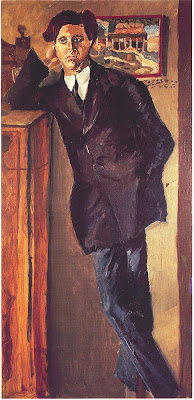
[Alban Berg, by Arnold Schoenberg)
The young renegade had little formal music education before he became a student of Arnold Schoenberg in October 1904, studying counterpoint, music theory, and harmony full-time by 1906.
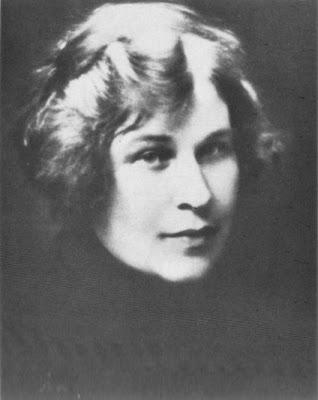
It was in that year that Berg met singer and future wife Helene Nahowski (1885-1976), daughter of a wealthy family (said by some to be in fact the illegitimate daughter of Emperor Franz Joseph I of Austria from his liaison with Anna Nahowski) despite the outward hostility of her family, and composition in 1907.
***
Jugendlieder II (1908)
***
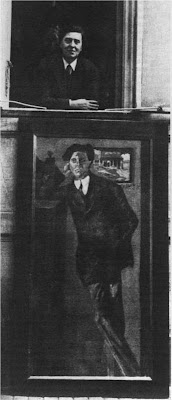
[Alban Berg -- above Alban Berg, by Arnold Schoenberg]
His student compositions included five drafts for piano sonatas. He also wrote songs, including his Seven Early Songs (Sieben Frühe Lieder), three of which were Berg's first publicly performed work in a concert that featured the music of Schoenberg's pupils in Vienna that year.
***
An Leukon (Johann Wilhelm Ludwig Gleim), voice and piano (1908)
Zwölf Variationen über ein Eigenes Thema in C, piano (1908)
***
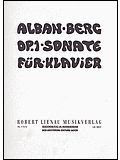
The early sonata sketches eventually culminated in Berg's Piano Sonata (Op. 1) (1908), one of the most formidable "first" works ever written.
Among Schoenberg's teaching was the idea that the unity of a musical composition depends on all its aspects being derived from a single basic idea; this idea was later known as developing variation. Berg passed this on to his own students, one of whom, Theodor Adorno, stated: "The main principle he conveyed was that of variation: everything was supposed to develop out of something else and yet be intrinsically different" The Piano Sonata is such a work, with the whole composition derived from the opening quartal gesture and phrase.
***
Vier Lieder (Four Songs), Op. 2, voice and piano (1910)

[The Alban Berg Quartet, 1971-2008]
String Quartet, Op.3 (1910)
***
Berg studied for six years, until 1911, with Schoenberg, whom he admired as a composer, mentor, close lifelong friend, and father figure -- for better and worse.
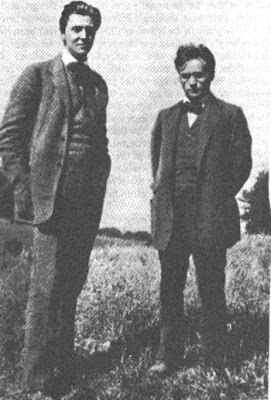
[Physicality determining destiny? -- The long and the short of it, with Alban Berg and Anton Webern, composers respectively of relatively lengthy and notoriously brief works]
Schoenberg, Anton Webern, and Berg are characterized as the Second Viennese School, and were members of Vienna's cultural elite during the heady pre-World War I period.
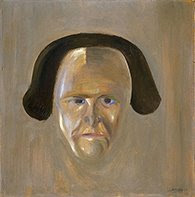
[Alexander von Zemlinsky, by Arnold Schoenberg]
Their circle included composers Alexander von Zemlinsky and

Franz Schreker;
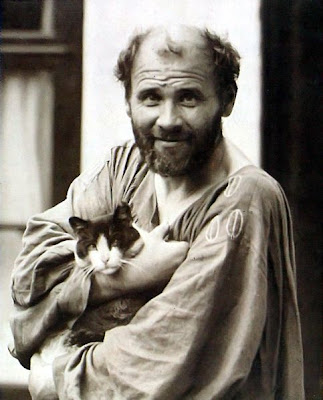
painter Gustav Klimt, the writer and satirist Karl Kraus,

architect Adolf Loos, and poet Peter Altenberg.
Alban and Helene were married on May 3, 1911.
In 1913, two of Berg's Five Songs on Picture Postcard Texts by Peter Altenberg (Fünf Orchesterlieder nach Ansichtkartentexten von Peter Altenberg a.k.a."Altenberg Lieder"), Op. 4 (1912), were premièred in Vienna, conducted by Schoenberg. Settings of aphoristic utterances, the soprano songs are accompanied by a very large orchestra. The performance caused a riot, and had to be halted; the work was not fully performed until 1952, and its full score finally published in 1966.
Vier Stücke (Four Pieces for Clarinet and Piano), Op. 5 (1913)
***
Drei Stücke (Three Pieces for Orchestra), Op. 6 (1915)
Alban Berg began his Op. 6 in late 1913. He had received harsh criticism from his former teacher, Arnold Schoenberg, about his previous two works in June of that year. According to Schoenberg, the Altenberg Lieder and the Four Pieces for Clarinet and Piano were too brief and were lacking in thematic complexity. In response to these criticisms, Berg set out to compose "character pieces of normal length, rich in thematic complexity, without striving for something 'new' at all costs" (Berg to Schoenberg, November 1915). Berg achieved the first and second but not the third of these goals.
The first and third movements (Präludium, Marsch) were completed August 23, 1914, weeks after the outbreak of the First World War (August 4). Self-criticism and the outbreak of the war ('the urge "to be in it"...to serve my country') slowed completion of the second movement, (Reigen). The work was finished in August 1915. In addition to being an attempt at winning Schoenberg's approval, Berg's Three Pieces were motivated by Berg's pre-occupation and affection for Mahler," especially his Symphony No. 9. Theodore Adorno wrote that, in his Op. 6, Berg "forgets all disciplining moderation and reaches towards chaos."
The Three Pieces connect the Schoenberg school with the pioneering composers who were "external to Schoenberg's orbit": Mahler and Debussy. Op. 6 became the composer's most complicated score, and this was because in it he responded to the mulitiplicity of Debussy's and Mahler's grand formal designs with the focus that was formerly reserved for the hyper-concentrated aphorisms of the Second Viennese School.
Berg's Three Pieces make explicit reference to Mahler "while affirming the collapse of the musical language" upon which the tradition is based. The harmonic language of the Op. 6 is "diffuse and ambiguous."
In such a work, there are no restrictions on what the composer may do, so "chaos is likely to ensue." However, as in earlier works, Berg generates "a large-scale musical structure by means of complex thematic operations." Stravinsky commented that Berg "is the only [modern composer] to have achieved large-scale development-type forms without a suggestion of 'neo-classic' dissimulation."
Contrary to Stravinsky's statement, however, "there are idiomatic elements of waltz, Ländler, and March in the Three Pieces."
The thematic techniques that serve in the Op. 6 to integrate the three movements into a large-scale structure are derived from those used in the pre-atonal works of Schoenberg, such as "complex transformation processes, germ motives, and the assignment of multiple functions to individual thematic elements (so that variants of a theme can be employed either melodically or as an accompaniment)."
Of Schoenberg's atonal orchestral scores only the Op. 16 had been performed at the time of Berg's composition of his Op. 6.
I. Preludio
The first movement "begins with the gradual emergence of percussive 'noise' out of silence, followed by an equally gradual transformation of these sounds into pitched configurations, a process that returns, in reversed order, at the end." The middle portion of the movement "builds to a single climactic point before falling away quickly near the end "Thus a definite, if approximate, palindrome is formed. In Präludium, "the principal melodic idea, fully formed only at m. 15, gradually coalesces out of fragmentary motivic particles during the first 14 measures."
II. Round Dance
III. Marsch
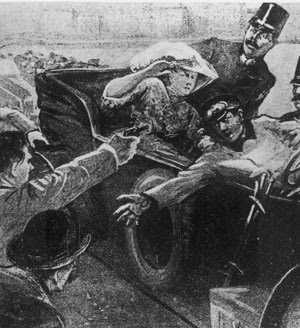
The third movement, "was completed in the weeks immediately following the assassination at Sarajevo and is, in its feeling of doom and catastrophe, an ideal, if unintentional, musical expression of the ominous implications of that event. Fragmentary rhythmic and melodic figures typical of an orthodox military march repeatedly coalesce into poyphonic episodes of incredible density that surge to frenzied climaxes, then fall apart" Adorno calls Marsch a montage: "at the beginning . . . four shattered old-fashioned march formulae are stitched together and reconstituted into form by the same force that had disintegrated them."
Another description: this movement has a "veritable thicked of thematic relationships [that] stands perhaps unrivalled in all music."
***
From 1915 to 1918, Berg served in the Austrian Army and during a period of leave in 1917 he began work on his first opera, Wozzeck. After the end of World War I, he settled again in Vienna where he taught private pupils. He also helped Schoenberg run his Society for Private Musical Performances.
***
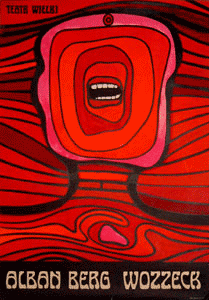
Wozzeck, Op. 7 (1922) is based on the drama Woyzeck left incomplete by the German playwright
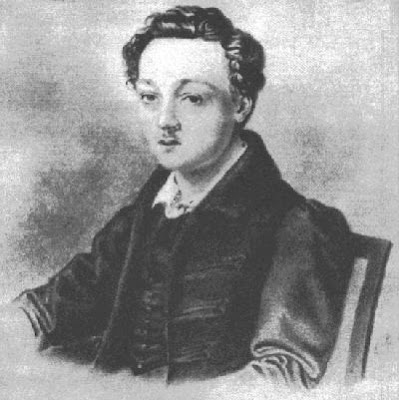
Georg Büchner at his death. Berg attended the first production in Vienna of Büchner's play (on May 5, 1914), and knew at once that he wanted to base an opera on it. From the fragments of unordered scenes left by Büchner, Berg selected 15 to form a compact structure of three acts with five scenes each. He adapted the libretto himself.
Though Berg began work on the opera in 1914, it was not until he was on leave from his regiment towards the end of World War I that he was able to devote his full attention to it, completing the opera in April 1922.
Act 1 (a five-movement suite of character pieces)
Scene 1
Berg uses a variety of musical techniques to create unity and coherence in the opera. The first is the use of leitmotifs. As with most composers who have used this method, each leitmotif is used in a much more subtle manner than being directly attached to a character or object. Even so, motifs for the Captain, the Doctor and the Drum Major are very prominent. Wozzeck is clearly associated with two motifs, one often heard as he rushes on or off stage, the other more languidly expressing his misery and helplessness in the face of the pressures he experiences.
The most significant motif is first heard sung by Wozzeck himself (in the first scene with the Captain), to the words 'Wir arme Leut' (poor folk like us). Tracing out a minor chord with added major seventh, it is frequently heard as the signal of the inability of the opera's characters to transcend their situation.
Scene 3, March and
 Lullaby (verse 1)
Lullaby (verse 1) (refrain 1)
(refrain 1) (verse 2)
(verse 2) (refrain 2)
(refrain 2)Such is Berg's skillful observation of real life that he is able to convey pictures of the ordinary (inside and outside Marie's room, and in the taverns) or the mundane (the snoring soldiers in their barracks). For these sections he drew on the style of popular folksong, using its rhythmic and melodic patterns in combination with his own harmonic and structural innovations.
The tritonal pair B natural and F natural, for example, represents Wozzeck and Marie, permanently in a struggle with one another. The combination of B flat and D flat (a minor third) represents the link between Marie and the child. In this way the opera continually returns to certain pitches to mark out key moments in the plot. This is not the same as a key center, but over time the repetition of these pitches establishes continuity and structure.
Scene 4
A set of passacaglia variations on a 12-note bass for the Doctor and Wozzeck.
Scene 5
Marie is accompanied by motifs that express her sensuality, as when she accepts a pair of earrings from the Drum major (an act that indicates that her submission to the 'rape' at the end of Act I was not so reluctant). A motif that is not explicitly linked with a physical object would be the pair of chords that are used to close each of the three acts, used in an oscillating repetition until they almost blur into one another.
Beyond this, Berg also reuses motifs from set pieces heard earlier in the opera to give us an insight into the character's thoughts. The reappearance of military band music, as in the last scene of Act I, for example, informs the audience that Marie is musing on the Drum major's physical desirability.
Act II (a five-movement symphony)
Scene 2
The Captain and Doctor taunt Wozzeck about Marie’s infidelity as a prelude and triple fugue.
Act III (five inventions -- six, counting the final interlude)
Scene 1 (invention on a theme)
Scene 2 (invention on a tone [B-natural])
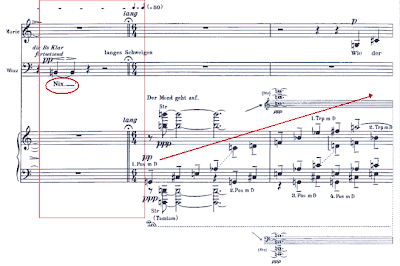 [Wozzeck: Nix! (The moon rises in a canon of brass)]
[Wozzeck: Nix! (The moon rises in a canon of brass)]Scene 3 (invention on a rhythm)
Scene 4 (invention on a scale)
Orchestral Epilogue (invention on a tonality [D minor])
Scene 5 (invention on a persistent rhythm)
Three excerpts from Wozzeck were performed in 1924, and this brought Berg his first public success.
Erich Kleiber conducted the world premiere at the Berlin State Opera on December 14, 1925. It quickly became so well established in the repertoire of the major European opera houses that Berg found himself able to live a comfortable life off the royalties. He spent a good deal of his time through the 1920s and 30s travelling to attend performances and to give talks about the opera. At Berg's death, his fellow pupil Anton Webern noted in a letter to their teacher, Arnold Schoenberg, how tragic it was that the most renowned of their trio was the first to die. That fame had come predominantly from the success of this opera.
***
Kammerkonzert (Chamber Concerto for Violin, Piano, and 13 Winds) (1925), was the first work begun in the year of Schoenberg's first completed 12-tone compositions, and reflects a new esthetic, combining the world of Mahlerian romanticism with a personal adaptation of dodecaphony.
***
Schliesse mir die Augen Beide (Theodor Storm), voice and piano (1925)
***
Lyrische Suite (Lyric Suite) (1926) was seemingly a significant influence on the String Quartet No. 3 of Béla Bartók.
Der Wein (Charles Baudelaire), concert aria, soprano and orchestra (1929)
Four-part Canon "Alban Berg an das Frankfurter Opernhaus" (1930)
***
Berg completed only the first two acts of his later (and 12-tone) opera, Lulu (1935), with the orchestration of Act 3 finished by Friedrich Cerha.
The elegiac Violin Concerto (1935), as in his other post-1923 works, employs a personal adaptation of 12-tone technique (including an opening flourish of stacked fifths) that enables the composer to combine frank atonality with passages that use more traditional tonal harmonies, such as quotations from a Bach chorale (which shares a succession of three rising whole tones with Berg's row) and a Carinthian folk song. The Concerto was dedicated to
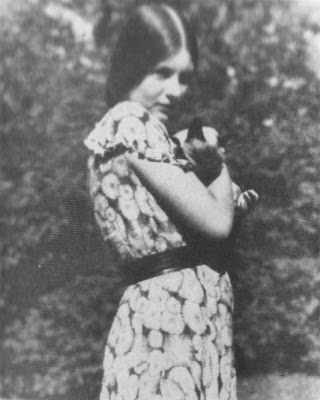
Alma Manon Gropius (1916-1935), the deceased 19-year-old daughter of architect
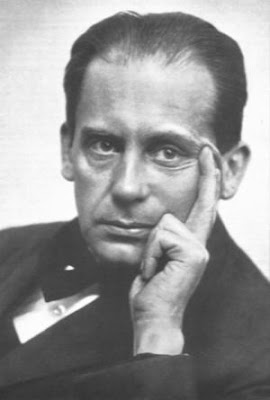
Walter Gropius (1883-1969) and
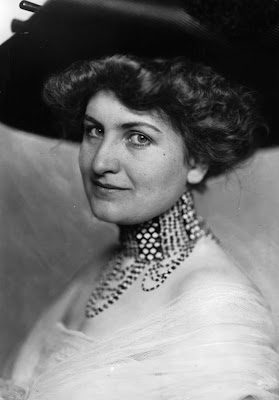
Alma Maria Schindler Mahler-Werfel (1879-1964), but this instrumental requiem can serve (as so many death masses have) for the composer as well.
Berg died in Vienna, on Christmas Eve 1935, apparently from blood poisoning caused by an insect bite, at 50.
In the late 20th and early 21st Centuries, the backward-looking Berg now looks among the most forward of his contemporaries.
[8885 Oliver / 8885 Berg / 8883 Varese]
